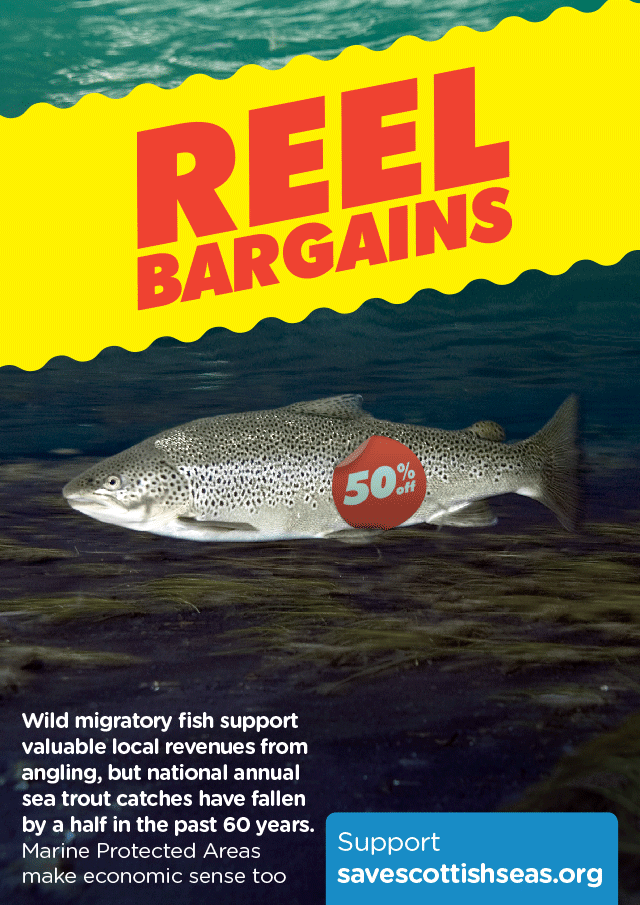 Sea trout, like many species in Scotland’s waters, are in decline. And not just a gradual decline; in some regions they are on a disturbing trajectory towards local extinction, having fallen by over 75% in 20 years [1]. Government advice infers from the latest sea trout rod catch statistics that spawning levels of this fish are at historically low levels.[2] This is bad news for obvious ecological reasons. It is also bad news for very interconnected economic ones.
Sea trout, like many species in Scotland’s waters, are in decline. And not just a gradual decline; in some regions they are on a disturbing trajectory towards local extinction, having fallen by over 75% in 20 years [1]. Government advice infers from the latest sea trout rod catch statistics that spawning levels of this fish are at historically low levels.[2] This is bad news for obvious ecological reasons. It is also bad news for very interconnected economic ones.
Sea trout are part of the natural, social and economic fabric of Scotland. For millennia a part of our diet, Scottish sea trout and salmon now attract anglers from all over the world.
A study in 2004 revealed that recreational anglers for sea trout and salmon spent a total of £73m in Scotland annually[3]. This is undoubtedly a substantial annual contribution to the coastal and rural areas of Scotland’s economy. A 1999 study suggested indirect and induced impacts of angling on the Western Isles economy amounted to £5.6m and accounted for 260 full time equivalent jobs – 2.7% of the working population[4].
These economic studies make clear that healthy stocks of sea trout and salmon are vital to the rural economy. And widespread declines in sea trout mean these financial benefits to local communities are under threat. The reasons for the declines vary throughout the country, but in the west where the issue is most pressing, they are mostly linked to the spread of disease. And again one thing is obvious; we need to act. Much work is already being done to conserve sea trout in river systems, but there is more we can do to protect sea trout in the marine environment.
What can we do about this?
Like salmon, sea trout move from freshwater into salt-water, but rather than migrating across the Atlantic like their salmonid cousins, sea trout spend the marine stage of their life cycle in inshore and estuarial waters. It is here that they are particularly vulnerable and where they are known to pick up lethal infections of sealice.
It is for this reason that Marine Protected Areas (MPAs) can help to protect sea trout. Sea trout are classed as a ‘Priority Marine Feature’ under new Scottish marine legislation and although they are not being used as one of the features to drive the selection of MPA sites, it is essential that once the sites have been identified, some must be managed specifically for the protection of sea trout and other migratory fish such as salmon. MPAs could also be managed to enhance the marine habitats and food sources which sea trout rely upon, for example by protecting eelgrass beds, maerl beds and sandeels.
Alongside other conservation measures, MPAs therefore could provide a vital boost to migratory fish in Scotland’s marine and freshwater environment. This of course is an end in itself – studies show that people are glad simply to know that fish live in our rivers[5]. But the potential trickle-down effects in the form of secure – and possibly increased – revenue from recreational game fishing is just one demonstration of how the health of our economy is underpinned by environmental health.
Despite such a compelling case, these nature conservation Marine Protected Areas are not yet in place. At the end of 2012, the Scottish Government received advice from SNH and JNCC on 33 MPA proposals and four MPA search locations in Scottish waters. Members of the Save Scottish Seas campaign remain seriously concerned about gaps in the network and its adequacy for the protection of certain important marine species and habitats. The campaign is therefore committed to helping make the MPA network as well-managed and ecologically coherent as possible.
This summer there is a public consultation about the proposed network. Find out how you can show your support for a strong, well-managed and ecologically-coherent network of Marine Protected Areas by visiting the Save Scottish Seas ‘get involved’ page…
[Updated from original article on 23rd August, 2013]
